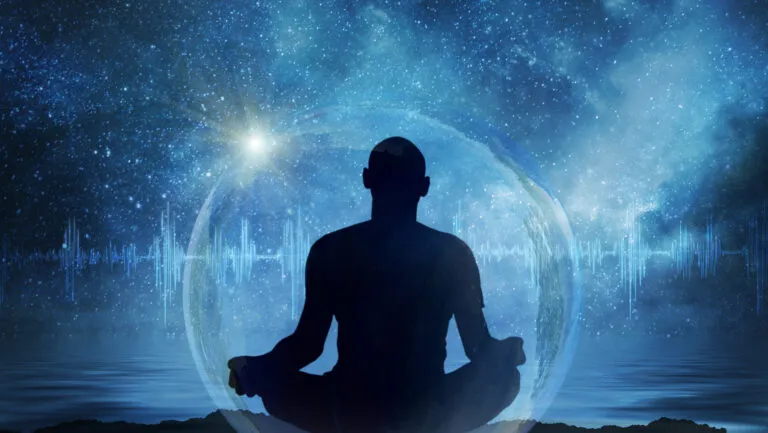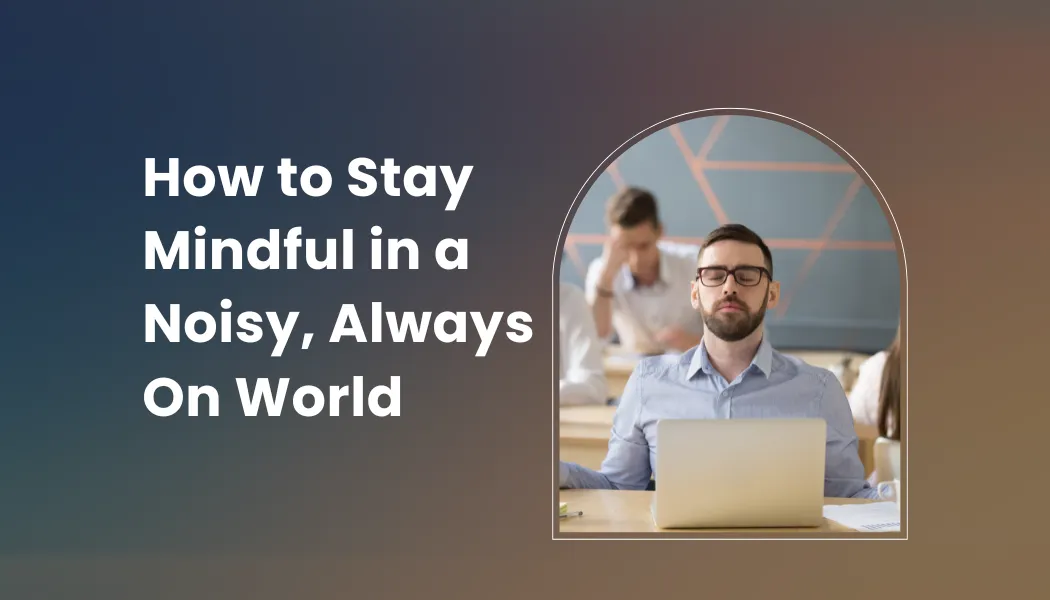In today’s world, silence has become a luxury.
From the moment we wake up to the time we fall asleep, our minds are bombarded with notifications, news, emails, and endless streams of digital chatter. We scroll while eating, check our phones between conversations, and even fall asleep to the hum of screens.
We live in a world that is always on—and while technology connects us more than ever, it also leaves many of us feeling scattered, anxious, and perpetually distracted. Amid this chaos, mindfulness offers a quiet refuge—a way to reclaim our attention, presence, and peace.
This is not about retreating to a monastery or turning off your phone forever. It’s about learning how to find calm within the noise. It’s about cultivating awareness wherever you are, so the world’s pace doesn’t dictate your inner state.
Table of contents
- The Noise That Never Ends
- What It Really Means to Be Mindful
- Why Mindfulness Matters Now More Than Ever
- How to Stay Mindful in the Midst of Noise
- 1. Start with Micro-Moments of Awareness
- 2. Create a Morning of Presence
- 3. Practice Single-Tasking
- 4. Mindful Breathing: Your Portable Reset Button
- 5. Limit Your Digital Noise
- 6. Reconnect with Your Senses
- 7. Embrace the Power of Pauses
- 8. Make Mindfulness Part of Your Routine
- 9. Mindful Listening in Relationships
- 10. Practice Gratitude Daily
- The Science Behind Staying Present
- When the World Feels Overwhelming
- Mindfulness Beyond the Self
- Bringing Stillness into a Busy Mind
- Practical Daily Mindfulness Plan
- The Paradox of the Modern Mind
- From Overwhelm to Awareness: Real-Life Examples
- How to Build a Sustainable Mindfulness Habit
- Mindfulness Is Not Escape—It’s Engagement
- Reclaiming Silence
- The Gift of Presence
The Noise That Never Ends
Let’s be honest: the world doesn’t stop buzzing.
The constant ping of messages, breaking news alerts, and the subtle pressure to “keep up” create a mental background hum that’s hard to escape. This digital noise doesn’t just fill our time—it consumes our attention.
According to research, the average person checks their phone more than 100 times a day. Many of us feel restless in silence or even guilty for being “unproductive.” But this overstimulation has a cost.
When our attention is constantly fragmented, our nervous system stays on high alert. We feel anxious, impatient, and disconnected—from others, from nature, and even from ourselves.
The result? We’re physically present but mentally elsewhere. We listen but don’t hear. We look but don’t see.
Mindfulness becomes the antidote to this mental noise—a way to return home to ourselves.
What It Really Means to Be Mindful
Mindfulness is not about forcing yourself to be calm or emptying your mind of thoughts. It’s about awareness.
It’s the simple, profound act of paying attention to the present moment—without judgment.
When you’re mindful, you’re not replaying the past or predicting the future. You’re right here, noticing the warmth of your coffee mug, the rhythm of your breath, or the sound of rain against the window.
Mindfulness doesn’t change the world around you—it changes how you experience it. It teaches you that peace is not found in perfect conditions, but in how you meet each moment.
The beauty of mindfulness is that it doesn’t require a special setting or schedule. You can practice it while walking, eating, talking, or even scrolling through your phone. It’s about doing whatever you’re doing fully present.
Why Mindfulness Matters Now More Than Ever
In an age of distraction, attention is our most valuable currency.

When we can’t focus, we can’t feel deeply. We rush through our days, multitasking our way into exhaustion. Mindfulness reclaims our ability to experience life rather than merely consume it.
Here’s what mindfulness offers in an always-on world:
- Clarity: It cuts through noise and helps you think clearly.
- Calm: It soothes the nervous system, reducing anxiety and overwhelm.
- Connection: It brings depth to conversations and relationships.
- Creativity: A calm mind sees patterns, ideas, and insights that a cluttered one can’t.
- Compassion: Presence fosters empathy—for yourself and others.
When we’re mindful, life stops feeling like something happening to us and starts feeling like something we’re part of.
How to Stay Mindful in the Midst of Noise
1. Start with Micro-Moments of Awareness
Mindfulness doesn’t require long meditation sessions. It begins in small, ordinary moments.
Pause before opening your email. Take one slow breath before answering a call. Feel your feet on the ground while waiting in line.
These tiny pauses train your brain to return to the present, even amid chaos. The more you practice, the more natural it becomes.
2. Create a Morning of Presence
The first moments of the day set the tone for everything that follows.
Instead of reaching for your phone immediately, take two minutes to simply be. Notice the sensations of waking—the air, the light, the stillness.
You could stretch, sip your coffee mindfully, or set an intention for the day such as, “I choose to move through today with awareness.”
When you start your day grounded, you’re less likely to be pulled into the whirlwind of noise later.
3. Practice Single-Tasking
Multitasking feels productive but scatters our attention. True focus, however, happens when we give one thing our full awareness.
When you eat, just eat.
When you walk, just walk.
When you listen, really listen.
Single-tasking not only boosts productivity but also deepens satisfaction. Life feels slower, richer, and more meaningful when you’re immersed in it fully.
4. Mindful Breathing: Your Portable Reset Button
Your breath is the simplest, most accessible anchor to the present.

Whenever you feel overwhelmed, take a slow breath in through your nose, hold it gently for a moment, and exhale through your mouth.
Notice how even a single mindful breath can calm the body and clear the mind.
Do this a few times throughout your day—before meetings, while commuting, or even while scrolling—and you’ll begin to feel more centered.
5. Limit Your Digital Noise
Technology isn’t the enemy—mindless use is.
Set small boundaries with your devices:
- Turn off non-essential notifications.
- Have “no phone” zones (like during meals or before bed).
- Schedule intentional offline time each day.
Use your phone consciously rather than compulsively. For instance, instead of checking social media out of boredom, decide, “I’ll browse for 10 minutes, then step away.”
These small digital boundaries give your mind room to breathe.
6. Reconnect with Your Senses
Mindfulness is a sensory experience. When the world feels overwhelming, grounding yourself in the senses brings you back to now.
Try this:
- Notice five things you can see.
- Four things you can touch.
- Three things you can hear.
- Two things you can smell.
- One thing you can taste.
It’s a simple yet powerful way to quiet mental noise and reconnect with your physical world.
7. Embrace the Power of Pauses
We often rush from one task to another, afraid to slow down. But pauses are where clarity lives.
Before answering a message, before reacting to someone’s words, before making a decision—pause.
In that moment of stillness, you gain space to choose your response instead of reacting automatically. This is one of mindfulness’s greatest gifts: it transforms reactivity into intentionality.
8. Make Mindfulness Part of Your Routine
Integrate mindfulness into activities you already do:
- Be mindful while brushing your teeth—notice the sound and movement.
- Be mindful while eating—appreciate flavor, texture, and aroma.
- Be mindful while walking—feel your steps connect with the ground.
When mindfulness becomes woven into daily life, you no longer need to “find time” for it—it becomes a way of being.
9. Mindful Listening in Relationships
In a noisy world, listening is a rare act of love.

When you talk to someone, give them your full attention. Don’t plan your response while they’re speaking. Just listen—to their words, their tone, their emotion.
This simple act deepens understanding and connection. People feel valued when they feel heard.
10. Practice Gratitude Daily
Gratitude and mindfulness go hand in hand. Gratitude anchors you in the goodness of the present, reminding you of what’s already enough.
At the end of each day, reflect on three things you’re thankful for. They don’t have to be grand—sometimes it’s the warmth of your bed, a kind message, or a moment of laughter.
This simple habit rewires your brain to notice beauty amid chaos.
The Science Behind Staying Present
Modern neuroscience confirms what ancient wisdom has long known: mindfulness changes the brain.
Studies show that regular mindfulness practice can:
- Reduce activity in the amygdala (the brain’s fear center).
- Strengthen the prefrontal cortex (responsible for focus and decision-making).
- Increase gray matter density in areas linked to memory and emotional regulation.
In essence, mindfulness trains your brain for balance. Over time, it becomes easier to handle stress, let go of distractions, and return to calm.
Even short daily practices—like five minutes of mindful breathing—can create measurable changes.
When the World Feels Overwhelming
There will still be days when the noise feels too much—when the inbox is overflowing, the news is heavy, and your mind won’t quiet down. On those days, remember: mindfulness is not about achieving perfect calm. It’s about noticing chaos without being consumed by it.
You can feel stressed and still be mindful. You can be sad and still be aware.
Try this grounding thought:
“I can’t control everything around me, but I can choose how I meet this moment.”
That single awareness is empowerment. It means you’re no longer swept away by the current—you’re learning to stand within it.
Mindfulness Beyond the Self
Mindfulness doesn’t just benefit the individual—it changes how we interact with the world.
When you’re mindful, you become more patient in traffic, more compassionate in conversations, and more attuned to the environment.
You start noticing the people behind the screens, the faces behind the crowds, the stories behind the noise.
Collectively, mindful individuals create mindful communities—workplaces with less burnout, families with deeper connection, societies with more empathy.
Bringing Stillness into a Busy Mind
You don’t have to escape the world to find peace.
You can find it within the world—right in the middle of your workday, your commute, your conversation, your chaos.

Stillness isn’t about silence; it’s about spaciousness. You can be in a bustling street and still feel calm inside. That’s the magic of mindfulness: it turns ordinary moments into gateways to peace.
Start small. Breathe. Observe. Appreciate.
Your attention is the most powerful tool you own. Wherever you place it, life grows.
Practical Daily Mindfulness Plan
Here’s a simple framework to help you stay mindful in your daily life:
| Time of Day | Mindful Practice | Purpose |
|---|---|---|
| Morning | 2 minutes of mindful breathing before touching your phone | Set your tone for calm presence |
| Midday | Take one mindful walk or stretch break | Reset your energy and focus |
| Afternoon | Eat one meal or snack mindfully | Deepen awareness and gratitude |
| Evening | Reflect on 3 good things from your day | Cultivate contentment |
| Night | 5 minutes of deep breathing before sleep | Calm your mind for rest |
Consistency matters more than duration. Even small steps, done daily, reshape your entire relationship with the world.
The Paradox of the Modern Mind
We live in an era of connection but crave deeper connection.
We have more information but less wisdom.
We’re constantly communicating but often not listening.
Mindfulness bridges that gap. It invites us to return to what’s real—the sensations, feelings, and presence that no screen can replicate.
When you quiet the outer noise, you start hearing the inner one—the voice that says, “I am here. I am enough. This moment matters.”
From Overwhelm to Awareness: Real-Life Examples
- The Commuter: Instead of scrolling during a train ride, you watch the scenery. You notice light, movement, and your breath. The journey becomes peaceful rather than stressful.
- The Parent: Instead of rushing bedtime, you pause to watch your child breathe. You realize these small moments are the big moments.
- The Worker: Instead of reacting to every notification, you check messages mindfully. You respond thoughtfully instead of impulsively. Productivity rises—and so does calm.
Mindfulness doesn’t change your life circumstances—it changes your relationship with them.
How to Build a Sustainable Mindfulness Habit
- Start small. One mindful breath is better than none.
- Attach it to existing habits. Pair mindfulness with brushing teeth, walking, or cooking.
- Be patient. Your mind will wander—that’s normal. Each time you notice, gently return.
- Celebrate awareness. Every moment you catch yourself drifting is mindfulness in action.
- Stay curious. Don’t judge your practice. Approach it with warmth and openness.
Over time, mindfulness becomes less of a task and more of a way of living.
Mindfulness Is Not Escape—It’s Engagement
Some misunderstand mindfulness as withdrawal. In truth, it’s the opposite.
Mindfulness makes you more engaged—with people, work, nature, and emotions.
You begin to experience life directly rather than through distraction. You taste food more vividly, hear music more deeply, and feel gratitude more often.
When you’re truly present, even ordinary days become extraordinary.
Reclaiming Silence
In a noisy world, silence is radical.
You don’t need hours of it—just moments. Turn off music for five minutes. Sit by a window. Let your mind rest.
Silence resets the soul. It reminds us that we are not defined by noise or busyness, but by awareness itself.
The Gift of Presence
Ultimately, mindfulness is about presence—being fully alive to your own life.
When you stay mindful, the world still buzzes around you, but you no longer lose yourself in it. You learn to be both observer and participant—to move through life’s chaos with calm, grounded attention.
The greatest irony of our time is that in trying to stay connected to everything, we’ve lost connection to ourselves. Mindfulness gives that back.
So pause. Breathe. Look around.
This moment—this breath—is enough.
The noise will continue, but peace is still possible. It begins not when the world grows quiet, but when you do.
Stay Inspired on Your Mindful Living Journey
If this article reminded you to slow down and breathe amidst the noise, here are a few more mindful reads that can help you find balance, clarity, and peace in a world that never seems to pause:
- The Power of Mindfulness: Finding Peace in the Present Moment – Learn how awareness and presence can turn ordinary moments into calm ones.
- The 30-Day Mindfulness Challenge: Transforming Your Daily Life – Build presence and balance with one mindful action each day.
- Mindfulness for Weight Balance and Healthy Habits: Nourishing Body and Mind – Explore how mindfulness strengthens both emotional and physical well-being.
- How to Cultivate Self-Compassion Through Mindful Living – Learn to be kinder to yourself while creating space for calm and clarity.
- Mindfulness and Ethical Decision-Making: The Quiet Power of Conscious Choices – Discover how awareness leads to wiser, more balanced choices every day.
